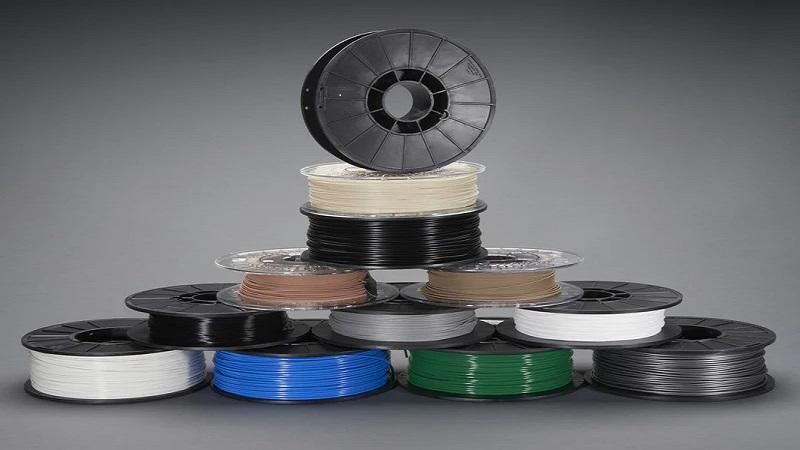The thermoplastic filament is desirable because of its features and low costs. In addition, PLA 3D printing material is strongly recommended for newbies who'd like to explore the 3D printing world.
Reading this article wholly will help you understand the following concepts about PLA thermoplastic filament:
●What exactly is PLA 3D printing material?
●What are the pros and cons of using PLA 3D printing material?
●Where is PLA 3D thermoplastic usable? (Applications)
●Top tips for using PLA 3D printing thermoplastic filament
Let’s dig right in!

What Exactly is PLA 3D Printing Material?
Polylactic acid (PLA) 3D printing material is an environmentally friendly 3D printing filament.
It is made from organic materials - cornstarch, sugarcane potato starch, etc. It, therefore, means that you can recycle a PLA 3D printing material after you're done with it, hence eco-friendly.
It is further compostable. The filament will start degrading after you've exposed it to a compostable industrial environment.
It is important to note that PLA 3D thermoplastic filament is only usable with FDM 3D printers.

It is one of the most popular FDM 3D printing materials alongside ABS. One of the primary reasons why PLA is popular is because it is economical.
In addition, PLA 3D printing material does not produce strong odors during printing compared with other FDM 3D printing thermoplastics. In contrast, it produces a sweet smell when heated during printing - similar to candy or waffles.
PLA 3D Printing Material Specifications
Thermoplastic Features | Specifications |
Cost | Low acquisition cost |
Strength | Stiff/Good strength |
Flexibility | Low flexibility |
Shelf life | Excellent shelf life |
Dimensional accuracy | Excellent dimensional accuracy - printed 3D model has ± 0.55mm |
Multi-color availability | Wide range of colors available - you can color-code your 3D models |
Outdoor performance | Poor outdoor performance due to sunlight exposure |
Thermoplastic Resistance | Specifications |
Heat resistance | Poor heat resistance - has a low melting point |
Water resistance | Average water resistance |
Chemical resistance | Poor chemical resistance |
Flame retardation | Poor flame retardation |
Thermoplastic Printing Temperature | Specifications |
PLA print temperature | 160°C (320°F) |
PLA bed temperature | 60°C - 80°C (140°F - 176°F) |
Extruder/nozzle temperature | 190°C - 210°C (370°F - 428°F) |
Cooling fan | Requires fan to cool - fan speed 100% |
PLA print temperature is relatively low compared to other filaments considering its strength. For example, its main competitor (ABS) has a print temperature of 240°C - 270°C (464°F - 518°F).
Using the heating bed is optional. You can further print 3D models without an enclosure using PLA 3D printing material. PLA thermoplastic does not pose a health risk when printing compared to other plastic filaments because it is organic.
You do not need a special hot end to print 3D models using PLA 3D printing thermoplastic filament.
What are the Advantages of Using PLA 3D Printing Material?
Using PLA 3D printing material is highly advantageous. Check out some of this filament’s benefits:
●Environmentally friendly - unlike other plastic thermoplastic filaments for FDM 3D printing, PLA is eco-friendly. However, PLA 3D printing material is compostable in an industrial setting only. Disposing of it like kitchen waste will not make it decompose.
●Easy to print - PLA 3D printing material melts at relatively lower temperatures than ABS 3D printing material. You can optionally use your FDM 3D printer's heat bed to print 3D models when using PLA thermoplastic filament.
In addition, PLA 3D printing material has excellent adhesion to different surfaces. The material does not warp during and after the printing process.
●Industrially biodegradable - PLA is made from organic sources. These organic sources have sugar, which is fermented to produce lactic acid. This lactic acid is then used to make polylactic acid.
Remember, you cannot dispose of PLA 3D printing material like kitchen waste. The recycling process has to happen in an industrial setting with controlled light, temperature, etc.
●Health-risk free - FDM printers print 3D models by heating a thermoplastic filament and then extruding it through a nozzle. When PLA 3D printing material is heated, it does not produce strong toxic fumes like plastics.
Instead, the thermoplastic filament produces a sweet aroma.
●Wide range of colors - PLA 3D printing material has diverse blends and colors. Choosing one or several color ranges is beneficial as it gives you the flexibility to color-code your 3D models or even print models with different colors.




















 sunrise
StableDiffusion
sunrise
StableDiffusion
 bonfire friends
StableDiffusion
bonfire friends
StableDiffusion
 sadness
StableDiffusion
sadness
StableDiffusion

 purple skies
StableDiffusion
purple skies
StableDiffusion

 true love
StableDiffusion
true love
StableDiffusion
 My Cheerleader
StableDiffusion
My Cheerleader
StableDiffusion
 womans transformation to happiness and love
StableDiffusion
womans transformation to happiness and love
StableDiffusion
 future life together of adventures
StableDiffusion
future life together of adventures
StableDiffusion

















